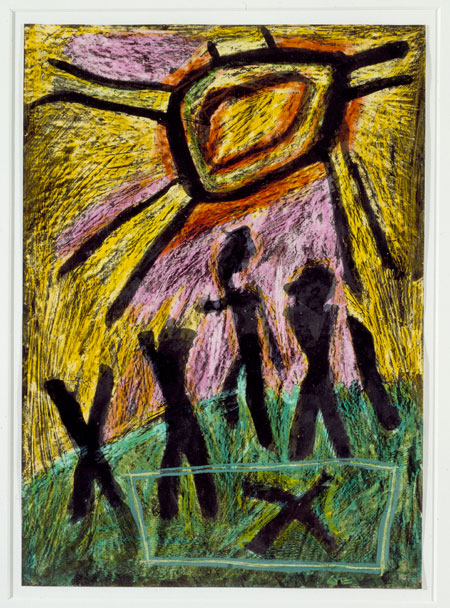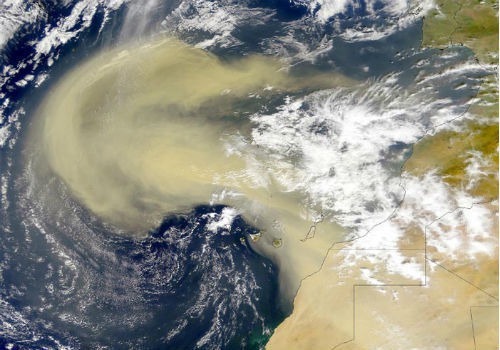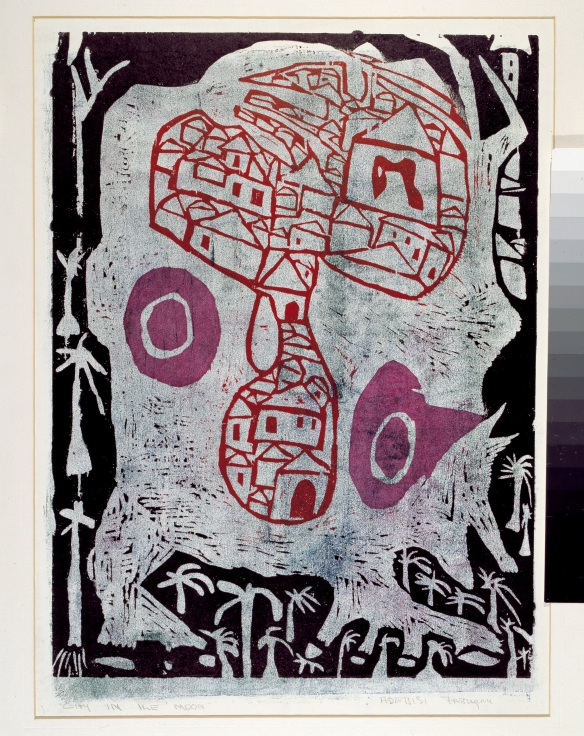Guest Voices: My Room at the Centre of the Universe
Our guest post this week is by South African artist Marcus Neustetter, whose work is featured in the African Cosmos exhibition. To see his work, visit: http://www.marcusneustetter.com/
My Room at the Centre of the Universe from Africa meets Africa on Vimeo.
In early 2012, Helene Smuts, director of the Africa meets Africa Project, invited a group of artists to join the production team of the latest in its series of educator resource books and films. The Africa meets Africa (AmA) project is an independent NGO which explores and documents southern African cultural heritage, seeking out solutions to contemporary learning problems in our schools by looking to the sophisticated visual language of traditional arts styles. An interdisciplinary research process has led to remarkably pragmatic learning solutions – such as presenting mathematical concepts in relation to the sophisticated symmetries of woven grass baskets and beaded adornments familiar to rural learners. The project stimulates critical thinking around the fluidity of ethnicity in its flow between urban and rural contexts
My Room at the Centre of the Universe is a 12 minute preview of a 60 minute film being directed by regular AmA film maker Guy Spiller. Together with a richly illustrated resource book, it departs from the act of sensitive and intensive observation common to the fields of astronomy, archaeology and the visual arts. A small Karoo farm outhouse becomes a space of contemplation and creativity for the main character, a 16 year old teenager from Sutherland. One small window in his room acts as a framing device through which he observes and contemplates the landscape, the skies, and ultimately the universe– much like telescopes used by physicists, or the views the Hubble telescope offers humankind.
Guest Voices: Philatelic Images- African Imagery of the Skies
Researchers and scientists have unraveled the mysteries of the cosmos over time like a puzzle, finding new stars and planets with ever-more powerful instruments. Several African postal authorities have honored such scientists as Galileo and Copernicus, as well as the discoveries they have uncovered. Djibouti issued a 1984 airmail issue (left) to commemorate the successful creation of Galileo’s telescope prototype in 1609, which allowed him to see and document elements such as sunspots, the phases of Venus and the satellites of Jupiter. Modern scientific advances have also been celebrated on African stamps, such as Mali’s issuance of a 1980 airmail stamp (below) celebrating the 50th anniversary of the discovery of Pluto, which made headlines around the globe when announced by Clyde Tombaugh at the Lowell Observatory in March 1930.
Perhaps the most enduring images however, are those of the phenomena that delight societies who look up at the night skies and marvel at what they see. Constellations of stars have been the subject of many stamp issues, and most recently from African nations such as Namibia and Mauritius. Pictured here (right) is one such image from a 2002 set of Mauritius showing the pattern of stars which make up the Scorpius sign (others in the set show the constellations Orion, Sagittarius and Crux).
Astronomy in Africa- News and Updates
- Last week, residents of Florida reported seeing hazy skies that were the result of dust travel from the African continent. The dust, coming from the Sahara desert, was carried across the Atlantic and landed in Southern Florida as a result of a mix of meteorological conditions.
- This week, Algeria set a deadline to accept construction bids for solar farms as as a step towards the nation’s progressive goal of 650 megawatts of solar energy by 2015. Similar efforts are underway in other nations in North Africa, including Egypt and Morocco.
Willem Boshoff On His Art
Teens at the Smithsonian’s ARTLAB+ produced and recorded a series of interviews with our own Chris Kreamer, curator of the African Cosmos exhibition, South African artist Willem Boshoff, and astrophysicists at the Smithsonian Astrophysical Observatory. Check out the third in this series of interviews below, which highlights South African artist Willem Boshoff, whose work is featured in the exhibition:
Astronomy in Africa- News and Updates
- Cameroon has announced that it will begin using satellite imagery to monitor and protect the country’s forest reserves. It will be using use images from the SPOT satellite Earth Observation System to create baseline maps in order to track changes to forest cover.
- SpaceX, headed by South African born Elon Musk, has been awarded a $82 million contract with NASA for the launch of the national Oceanic and Atmospheric Administration’s Jason-3 spacecraft, scheduled to launch in December 2014.
Cosmic Connections
Guest Voices- South African Astronomy Stamps
Our guest post this week is by South African artist Marcus Neustetter, whose work is featured in the African Cosmos exhibition. To see his work, visit: http://www.marcusneustetter.com/
On the invitation of the South African Post office to design a stamp series celebrating South Africa’s role in astronomy, I further developed my existing research and network at the intersection of art science and technology. My contribution was beyond the designing of the stamps, to negotiating the inclusion of various agencies and facilities, as well as acknowledging the traditional history and astronomical societies that make the local approach to astronomy rich and layered.
While I was focused on designing each stamp and the first day covers to be both accessible and artistic in conceptual approach and execution, a few key elements maintained throughout the design process. I wanted to work with the technology of the stamp, which resulted in the perforated stamp sheet, the foiling, that echoes the mirroring of the technology used in most of star observation– integrating my own drawings into a dialogue with the facilities, agencies, or represented data.
The marks, drawn in the dark while observing the space between the stars in the night sky of Sutherland in the Karoo region, and data collected from the different observatories, has informed the representation of what I like to call the unexplainable, the unknown, the imaginary, the magic.
For more information and a closer look at the stamp series, click here.
Astronomy in Africa- News and Updates

Visualization of SKA dishes at night. Credit: SKA Organisation/TDP/DRAO/Swinburne Astronomy Productions
- Yesterday marked the end of a two-day summit hosted at the University of Pretoria to discuss the future of the SKA South Africa site. Astronomers and government officials discussed the benefits that would arise from the project, with human capital development named as the priority.
- This week Morocco hosts the Global Hands On Universe conference, which brings together teachers, scientists and educators from high schools, universities, research centers, and science centers from around the world to discuss various topics in science education. Global astronomy projects and the connections between astronomy and culture will be key points of discussion for this week’s conference.
Theories of Creation
Teens at the Smithsonian’s ARTLAB+ produced and recorded a series of interviews with our own Chris Kreamer, curator of the African Cosmos exhibition, South African artist Willem Boshoff, and astrophysicists at the Smithsonian Astrophysical Observatory. Check out the second in this series of interviews below, which highlights the astrophysicists involved in this exhibition:











